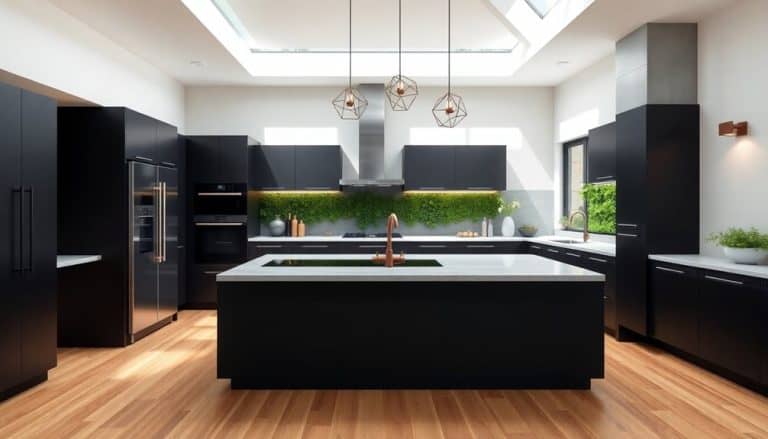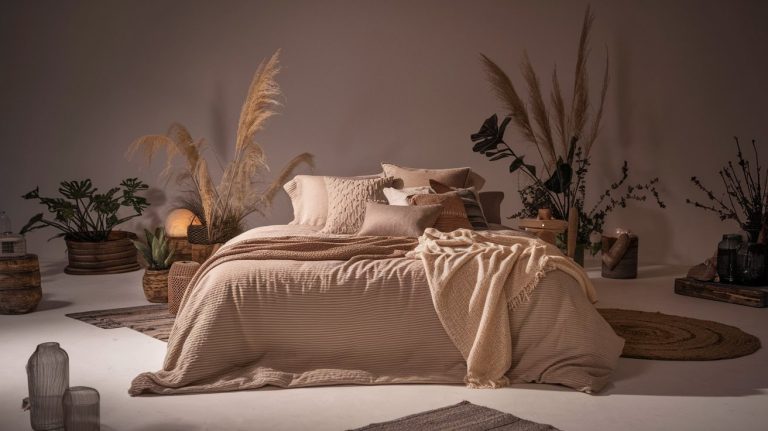This website contains affiliate links. Some products are gifted by the brand to test. As an Amazon Associate, I earn from qualifying purchases. The content on this website was created with the help of AI.
Your 2024 home will revolutionize daily living through transformative design rules that merge cutting-edge technology with wellness-focused spaces. You’ll control smart walls that shift from opaque to transparent, while AI-powered vertical gardens and circadian lighting create a nurturing biophilic environment. Sustainable luxury takes hold with recycled materials and mycelium composites, while multifunctional spaces adapt to your needs through VR-optimized layouts. Strategic color psychology and architectural lighting will enhance your emotional well-being, from anxiety-reducing blues in workspaces to conversation-sparking corals in social zones. The future of interior design holds even more groundbreaking innovations.
Key Takeaways
- Smart walls with integrated technology will replace traditional static walls, offering customizable transparency and built-in entertainment systems.
- Sustainable and recycled materials, including reclaimed wood and innovative composites, will dominate luxury interior design choices.
- Multifunctional furniture and adaptable spaces will become standard, maximizing utility in homes through modular design solutions.
- Biophilic elements with AI-powered features will merge nature and technology through self-maintaining vertical gardens and smart windows.
- Strategic color psychology and architectural lighting will create emotionally responsive environments that enhance wellbeing and productivity.
Smart Walls Take Center Stage

Beyond the era of static paint and wallpaper, smart walls are revolutionizing today’s interior spaces. You’ll discover walls that transform from opaque to transparent at the touch of a button, display immersive digital art collections, and respond to voice commands. These interactive surfaces seamlessly integrate ambient lighting, climate control, and entertainment systems while maintaining a sleek, minimalist aesthetic.
Your walls can now adapt to your daily rhythm, shifting from energizing morning hues to calming evening tones. Built-in LED matrices create stunning visual effects, while nano-sensors monitor air quality and room temperature. You’ll appreciate how smart walls eliminate the need for multiple devices, as they incorporate speakers, displays, and charging stations within their structure.
For maximum impact, position your smart wall as a focal point in high-traffic areas like living rooms or home offices. Consider programming customized scenes that coordinate with your schedule – from productive workday settings to relaxing weekend modes. When selecting smart wall features, prioritize those that complement your lifestyle while maintaining a cohesive design language throughout your space.
Biophilic Design Meets Technology
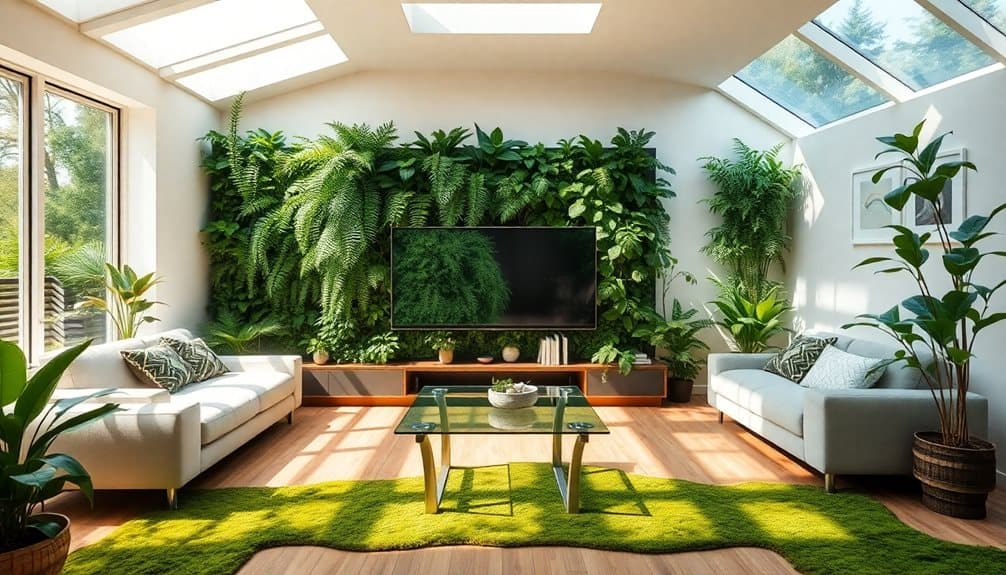
Merging nature with cutting-edge technology, biophilic design has evolved far beyond potted plants and nature prints. You’ll now find AI-powered vertical gardens that automatically adjust their lighting and moisture levels, while smart windows tint themselves to optimize natural light throughout the day. Living walls incorporate hydroponic systems with built-in sensors that monitor plant health and nutrient levels in real-time.
You can transform your space with programmable circadian lighting that mimics natural daylight patterns, supporting your body’s internal rhythm while bringing the outdoors in. Smart planters equipped with IoT sensors will notify your phone when it’s time to water, prune, or fertilize your greenery. Digital art displays seamlessly shift between calming nature scenes, while sonic technology pipes in authentic forest sounds that adjust to your daily routine.
The newest biophilic innovations include self-maintaining moss walls with integrated air purification systems, and responsive water features that create patterns based on your home’s activity levels. You’ll find that these tech-enhanced natural elements don’t just look stunning – they’re actively working to improve your home’s air quality, acoustics, and overall well-being.
Multifunctional Spaces Define Living
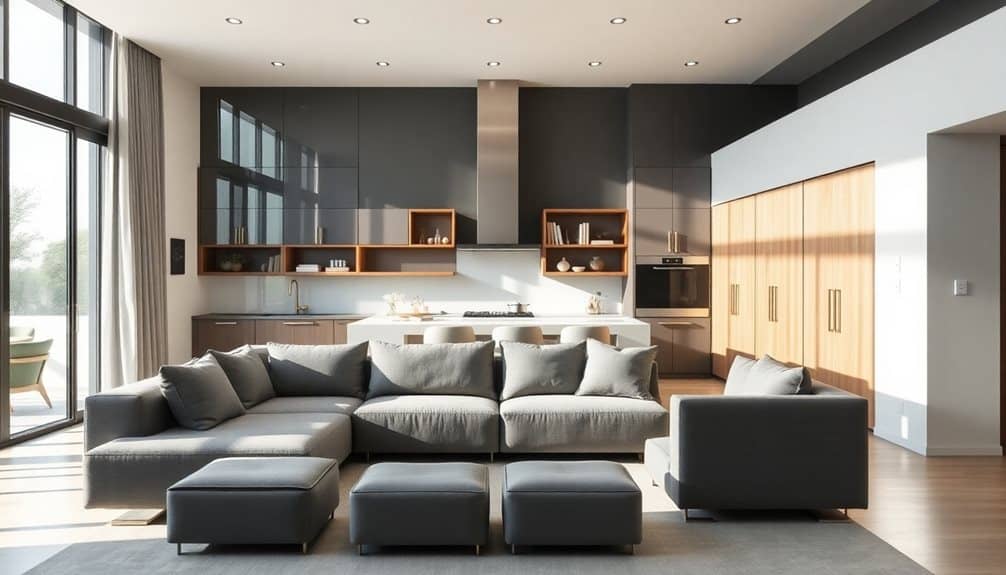
Today’s homes work double duty as flexible spaces that seamlessly shift between living, working, and entertaining. You’ll find that modular furniture and adaptable room layouts are becoming essential elements in creating versatile environments. Consider investing in pieces like expandable dining tables that transform into conference surfaces or sleek murphy beds that disappear to reveal home office setups.
Smart storage solutions play a pivotal role in maintaining these dynamic spaces. You’ll want to incorporate built-in cabinets with adjustable shelving, ottoman coffee tables with hidden compartments, and vertical storage systems that maximize wall real estate. Look for furniture pieces that serve multiple purposes, such as room dividers with integrated bookshelves or console tables that extend into full dining surfaces. Portable storage carts provide an excellent way to keep organized while maintaining the flexibility to rearrange spaces as needed.
The key to successful multifunctional design lies in zoning techniques. You can define distinct areas using strategic lighting, area rugs, or mobile partition systems. Install track lighting with programmable settings for different activities, and opt for furniture on wheels that you can easily reconfigure. Remember to maintain visual cohesion through consistent color schemes and materials, ensuring your space feels intentional rather than cluttered, regardless of its current function.
Sustainable Materials Go Luxe
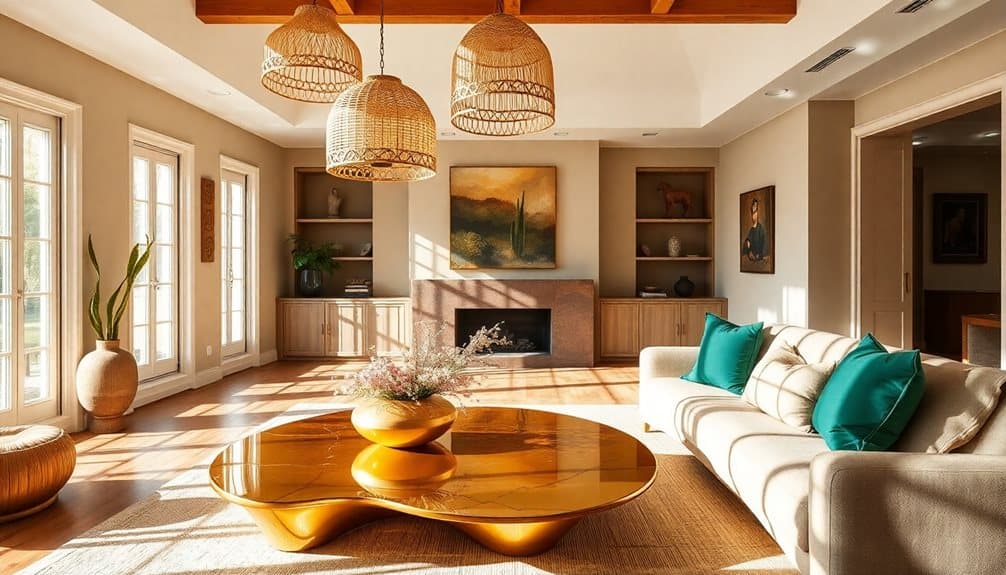
While functional spaces define modern living, the materials we choose reflect our commitment to both luxury and environmental responsibility. You’ll find reclaimed wood transformed into sleek floating shelves, and recycled glass crafted into stunning backlit countertops. These aren’t your typical eco-friendly materials – they’re elevated, refined, and unmistakably premium.
Cork’s making a sophisticated comeback, appearing as textured wall panels and ultra-modern flooring that’s both sustainable and sound-dampening. You’ll want to incorporate bamboo, not just as accent pieces, but as statement furniture with clean lines and rich finishes. Look for innovative composites like mycelium-based materials that mimic leather and innovative bio-plastics that rival traditional luxury surfaces.
Don’t overlook the beauty of recycled metals – copper, brass, and aluminum are being reimagined into striking light fixtures and architectural details. You can pair these with organic linens and responsible wool textiles that carry impeccable environmental certifications. The key is selecting materials that tell a story of conservation while delivering the polish and sophistication you’d expect from high-end design. It’s about making sustainable choices that don’t compromise on style or quality. Perfect the ambiance by installing warm lighting temperatures between 2700K-3000K to complement natural materials and emphasize their luxurious appeal.
Color Psychology Drives Design

Color’s profound impact on human psychology shapes every thoughtful interior design choice. Understanding how different hues affect mood and behavior will drive 2024’s most successful spaces, with designers leveraging color science to create purposeful environments.
You’ll want to incorporate blues and greens in spaces meant for focus and productivity, as these colors reduce anxiety and enhance concentration. For social areas, warm yellows and soft corals encourage conversation and create an inviting atmosphere. Deep purples and rich burgundies add sophistication to formal spaces while promoting creativity and introspection.
The key is layering colors strategically. You’re not just choosing a single shade, but crafting a complete psychological journey through your home. Start with a neutral base, then add primary mood-influencing colors at eye level, and accent with complementary hues that reinforce your intended emotional impact.
Don’t forget about color temperature shifts between rooms. You’ll create cognitive dissonance if you jump from energetic reds to calming blues without proper connecting spaces. Instead, use gradient approaches and thoughtful color flow to guide occupants naturally through different emotional states as they move through your home.
Personalized Lighting Systems

Every interior’s ambiance hinges on the strategic implementation of personalized lighting systems. You’ll need to layer your lighting with precision, combining ambient, task, and accent lighting to create depth and visual interest. Start by mapping out your daily routines and identifying where you need focused illumination versus soft, atmospheric light.
Smart LED systems now allow you to program specific lighting scenes that align with your circadian rhythm. You’ll find that cool, bright lights energize your morning routine, while warm, dim settings help you wind down in the evening. Install app-controlled bulbs that adjust color temperature and intensity based on time of day, weather conditions, and your personal preferences.
Don’t overlook the transformative power of architectural lighting. Integrate LED strips under cabinets, along stairs, or behind mirrors to add dimension to your space. Position adjustable track lighting to highlight artwork or architectural features, and incorporate dimmers throughout to fine-tune the atmosphere. Remember to take into account natural light patterns when planning your artificial lighting scheme – you’ll want your system to complement, not compete with, daylight hours.
Wellness-Focused Room Planning
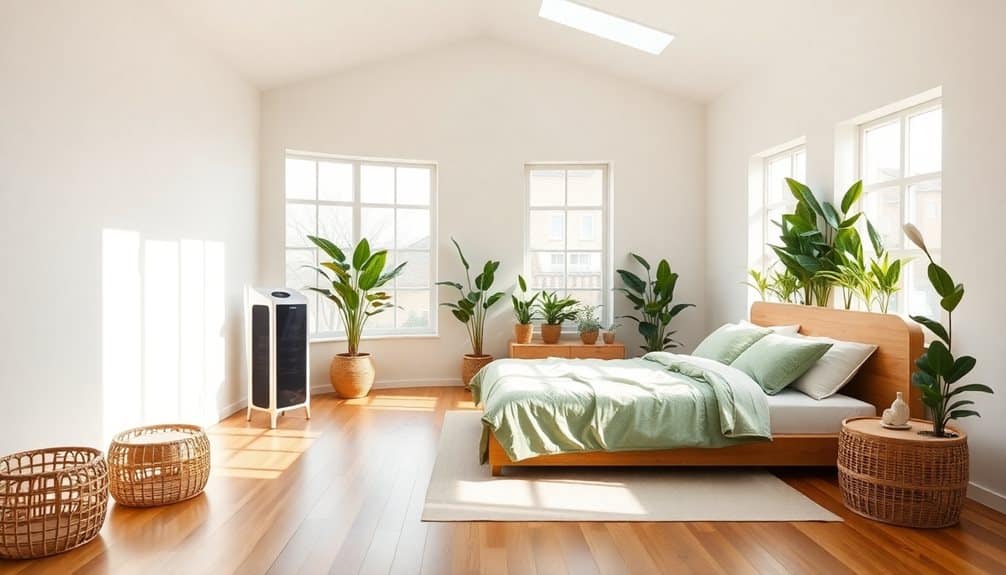
Creating a wellness-focused room layout builds upon smart lighting by addressing our fundamental need for healthy living spaces. You’ll want to position furniture to maximize natural light exposure while establishing clear pathways that promote easy movement throughout your home. Consider dedicating 20% of each room to open space, allowing for stretching, meditation, or simple breathing exercises.
Incorporate biophilic elements by designating spots for air-purifying plants near high-traffic areas and workstations. You’ll benefit from positioning your desk to face east, capitalizing on morning light while maintaining a view of your door – a principle known as the “command position.” Create wellness zones by grouping fitness equipment, yoga mats, or meditation cushions in corners with ideal ventilation.
In your bedroom, position your bed away from electromagnetic sources and external walls to improve sleep quality. Design your kitchen layout to encourage healthy eating habits by keeping nutritious options visible and accessible. Install water stations throughout your home to promote hydration, and incorporate sound-absorbing materials to reduce noise pollution. You’ll find that these intentional choices transform your space into a sanctuary that actively supports your physical and mental wellbeing. Consider adding a small indoor greenhouse with UV-resistant panels to create a year-round growing space for fresh herbs and vegetables.
Virtual Reality Design Integration

Technology revolutionizes home design through virtual reality tools that let you visualize spaces before committing to changes. Using VR headsets and specialized design apps, you’ll experience your future room layouts in immersive 3D, allowing you to walk through different design scenarios and make confident decisions about furniture placement, color schemes, and spatial flow.
Advanced VR platforms now integrate with major retailers’ catalogs, enabling you to swap furniture pieces, test lighting conditions, and experiment with textiles in real-time. You’ll spot potential design flaws before they become costly mistakes and refine your vision with precision.
- Use VR room scanning to create an exact digital twin of your space, complete with accurate measurements and architectural details
- Test seasonal decor changes by switching between pre-saved design configurations for different times of the year
- Share your virtual design with professionals or friends for remote collaboration and instant feedback
The integration of VR technology transforms the traditional design process into an interactive experience where you’ll perfect every detail before making a single purchase or moving any furniture.
Similar to adjustable hive stands, VR design tools allow you to test different height and width configurations to maximize space efficiency in your room layout.
Frequently Asked Questions
How Much Do Professional Home Decor Consultants Charge for 2024 Design Plans?
You’ll find professional home decor consultants charging between $150-$500 per hour in 2024, with extensive design plans ranging from $2,000 to $12,000. Virtual consultations start at $75/hour, while premium full-service packages can reach $25,000. Your location, project scope, and consultant’s expertise level impact pricing. Many designers now offer flexible payment plans and tiered service options to match different budgets.
Can Trending 2024 Design Elements Be Incorporated Into Rental Properties?
Like a butterfly transforming its cocoon into a stunning display, you can refresh your rental with 2024’s hottest trends using non-permanent solutions. Try peel-and-stick wallpaper in biophilic patterns, modular furniture pieces, and smart LED lighting strips. You’ll love incorporating sustainable bamboo accessories, removable textile wall hangings, and multifunctional mirrors with built-in charging stations. Don’t forget clip-on hardware updates for cabinets and temporary floor overlays.
What Insurance Considerations Should Homeowners Make When Installing Smart Home Features?
You’ll want to update your homeowner’s policy to specifically cover smart devices, including potential cyber breaches and system failures. Consider additional liability coverage for connected security systems and automated features. Don’t forget to document all installations, keep receipts, and notify your insurer about professional versus DIY installations. Many providers now offer smart home discounts, so ask about premium reductions for your tech upgrades.
How Will 2024 Design Trends Affect Home Resale Values?
Purposeful, practical projects will positively impact your property’s value. You’ll see higher returns by incorporating sustainable materials, smart home integration, and multifunctional spaces. Buyers are willing to pay premium prices for homes featuring biophilic elements, natural light optimization, and energy-efficient designs. Your investment in flexible workspaces, wellness-focused bathrooms, and automated systems will make your property more appealing in the competitive real estate market.
Which Design Certifications Will Be Most Valuable for Interior Designers in 2024?
You’ll want to prioritize sustainability-focused certifications like LEED and WELL in 2024, as eco-conscious design becomes non-negotiable. The NCIDQ will remain essential, but you should also pursue specialized certifications in smart home integration and biophilic design. Don’t overlook emerging credentials in VR/AR design presentation and aging-in-place specifications – they’ll give you a competitive edge in the evolving market.


